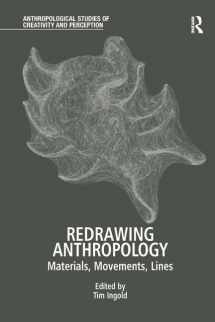
Redrawing Anthropology: Materials, Movements, Lines (Anthropological Studies of Creativity and Perception)
ISBN-13:
9781409417743
ISBN-10:
1409417743
Edition:
1
Author:
Tim Ingold
Publication date:
2011
Publisher:
Routledge
Format:
Hardcover
216 pages
FREE US shipping
Book details
ISBN-13:
9781409417743
ISBN-10:
1409417743
Edition:
1
Author:
Tim Ingold
Publication date:
2011
Publisher:
Routledge
Format:
Hardcover
216 pages
Summary
Redrawing Anthropology: Materials, Movements, Lines (Anthropological Studies of Creativity and Perception) (ISBN-13: 9781409417743 and ISBN-10: 1409417743), written by authors
Tim Ingold, was published by Routledge in 2011.
With an overall rating of 4.0 stars, it's a notable title among other
books. You can easily purchase or rent Redrawing Anthropology: Materials, Movements, Lines (Anthropological Studies of Creativity and Perception) (Hardcover) from BooksRun,
along with many other new and used
books
and textbooks.
And, if you're looking to sell your copy, our current buyback offer is $0.58.
Description
Why should anthropologists draw? The answer proposed in this groundbreaking volume is that drawing uniquely brings together ways of making, observing and describing. In twelve chapters, a team of authors from the UK, Europe, North America and Australia explore the potential of a graphic anthropology to change the way we think about creativity and perception, to grasp the dynamics of improvisatory practice, and to refocus the study of material culture from ready-made objects onto the flows of materials involved in the generation of things. Drawing on expertise in fields ranging from craftwork, martial arts, and dance to observational cinema and experimental film, they ask what it means to follow materials, to learn movements and to draw lines. Along the way, they contribute to key debates on what happens in making, the relation between design and performance, how people acquire bodily skills, the place of movement in human self-awareness, the relation between walking and imagination, and the perception of time. This book will appeal not just to social, cultural and visual anthropologists but to archaeologists and students of material culture, as well as to scholars across the arts, humanities and social sciences with interests in perception, creativity and material culture.


We would LOVE it if you could help us and other readers by reviewing the book
Book review

Congratulations! We have received your book review.
{user}
{createdAt}
by {truncated_author}


